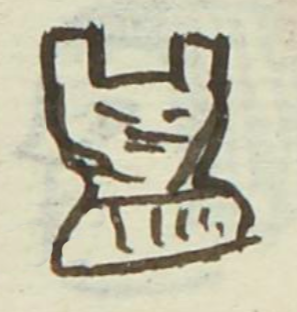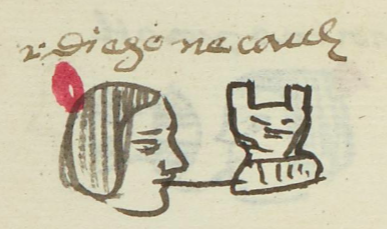Nencauh (MH568r)
This black-line drawing of the simplex glyph for the personal name Nencauh (“Negligent One,” or "Abandoned One," attested here as a man’s name) shows a blocky figure that may intend to represent a representation of a divine force or doll (nenetl). It starts at the shoulders and goes up through the face and ends with two protrusions on top of the head. It is difficult to say if this represents a female figure; two points on top of the head are reminiscent of the Cuauhtecolotl, which seems like something of a divine force the way it is drawn, and one of the Xolotl glyphs (see below).
Stephanie Wood
The use of nenetl as a starting syllable "Nen-" typically features a figurine of a deity and sometimes a doll, but the meaning is really a negative adjective for personality traits or other unfortunate circumstances that might befall a person. (See other examples of this Nen- below). So, this nenetl becomes a phonetic syllable with a very different meaning.
The five extra days in the calendar of 360 days (xiuhpohualli) were called nemontemi (useless days). It was unlucky to be born on these days. A man who was born in this period was called nenoquich and a woman was called nencihuatl. This is explained in the Florentine Codex in Book 2, folio 12 recto (see: https://florentinecodex.getty.edu/book/2/folio/12r). These individuals were considered unlucky, ill-fated, and even useless. A great many individuals in the Matrícula de Huexotzinco have names beginning with the negative syllable Nen-. Perhaps they were born in that ill-fated period, or perhaps the negative syllable came to be even more liberally applied. With men, for instance, Nentequitl (perhaps a lazy worker) was much more common than Nenoquich. When presented visually, the nen- syllable could derive from nenetl (a figure or sculpture of a deity or a doll). Nenetl also had an association with women’s genitals, which has caused much speculation about a negativity associated with women and their sex, but that might have come from European religious influence. In the colonial context, such concepts and perceptions could become muddied.
Stephanie Wood
diego necauh
Diego Nencauh
Stephanie Wood
1560
Stephanie Wood
phonetic syllables, sílabas fonéticas, work, labor, trabajo, dolls, muñecas, nenetl, imágenes de deidades, esculturas de piedra, genitales de mujeres, mal comportamiento, madera, herramienta agrícola, coa

nencauh, negligent or abandoned person, https://nahuatl.wired-humanities.org/content/nencauh
cahua, to leave, abandon, https://nahuatl.wired-humanities.org/content/cahua
nene(tl), deity image, https://nahuatl.wired-humanities.org/content/nenetl
La Persona Negligente, o El Abandonado
Stephanie Wood
Matrícula de Huexotzinco, folio 568r, World Digital Library, https://www.loc.gov/resource/gdcwdl.wdl_15282/?sp=215&st=image.
This manuscript is hosted by the Library of Congress and the World Digital Library; used here with the Creative Commons, “Attribution-NonCommercial-ShareAlike 3.0 License” (CC-BY-NC-SAq 3.0).










